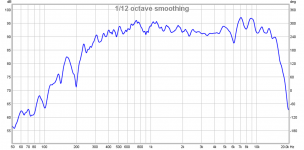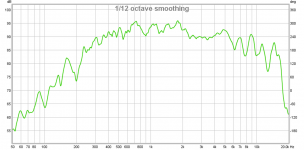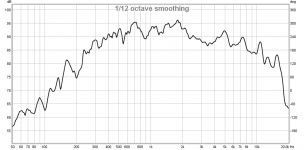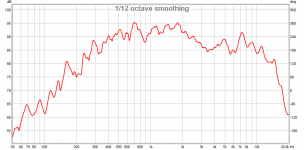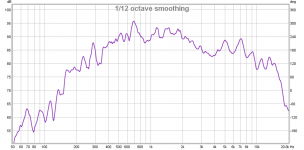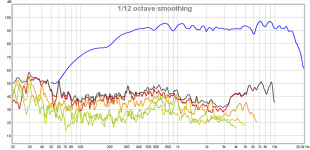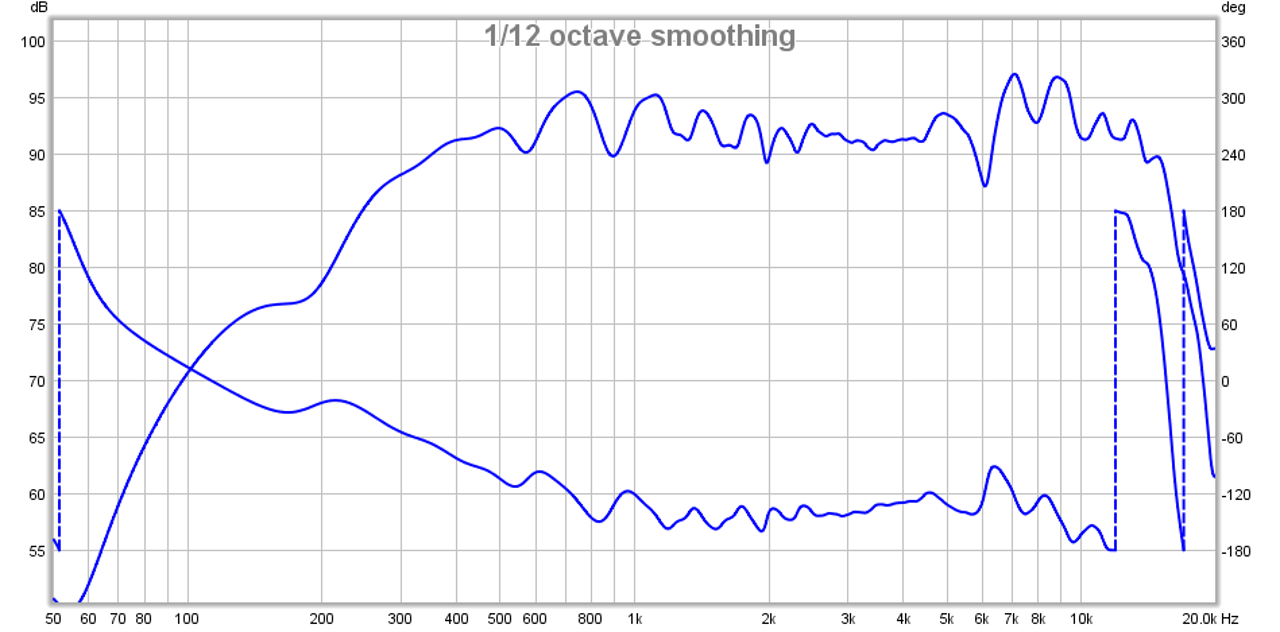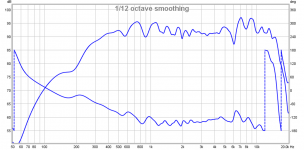Hi
Woofer can go to 12 khz easely, it is a old phillips who sounds very well.
A fullrange will not do in a conic synergy, yes for your hor it will and I have cute visaton
FRS8M full rangers.
Don,t forget a big throat chamber can also give trouble with resonances that is wht professional horns use plugs.
But tryout is the best teacher I think and your design I like also, and maybe it that what go start, I need only the old autocad 2000, because the new one is so overdone big and ask again and again to join a site.
regards
kees
Woofer can go to 12 khz easely, it is a old phillips who sounds very well.
A fullrange will not do in a conic synergy, yes for your hor it will and I have cute visaton
FRS8M full rangers.
Don,t forget a big throat chamber can also give trouble with resonances that is wht professional horns use plugs.
But tryout is the best teacher I think and your design I like also, and maybe it that what go start, I need only the old autocad 2000, because the new one is so overdone big and ask again and again to join a site.
regards
kees
12khz open faced but the moment you put it in a chamber with a throat, getting 1khz is very tough as you see. You don't need acad to make the profie, just pull the numbers off the spreadsheet and use a plotting program. As long as it is drawn to scale in x&y then scale drawing in pdf "tile" function for plans. You cannot make unrolled curved surface without 3d package anyway, and will have to do the old style template at the centerline profile.
New thread for the 0.7x scale Synergy here:
http://www.diyaudio.com/forums/full-range/261427-40-full-range-synergy.html
http://www.diyaudio.com/forums/full-range/261427-40-full-range-synergy.html
OB Data with higher resolution
Here is the data for the 5MR450NDY mounted in my OB setup (slot loaded OB) with 5 dB major tic increments.
0 deg:
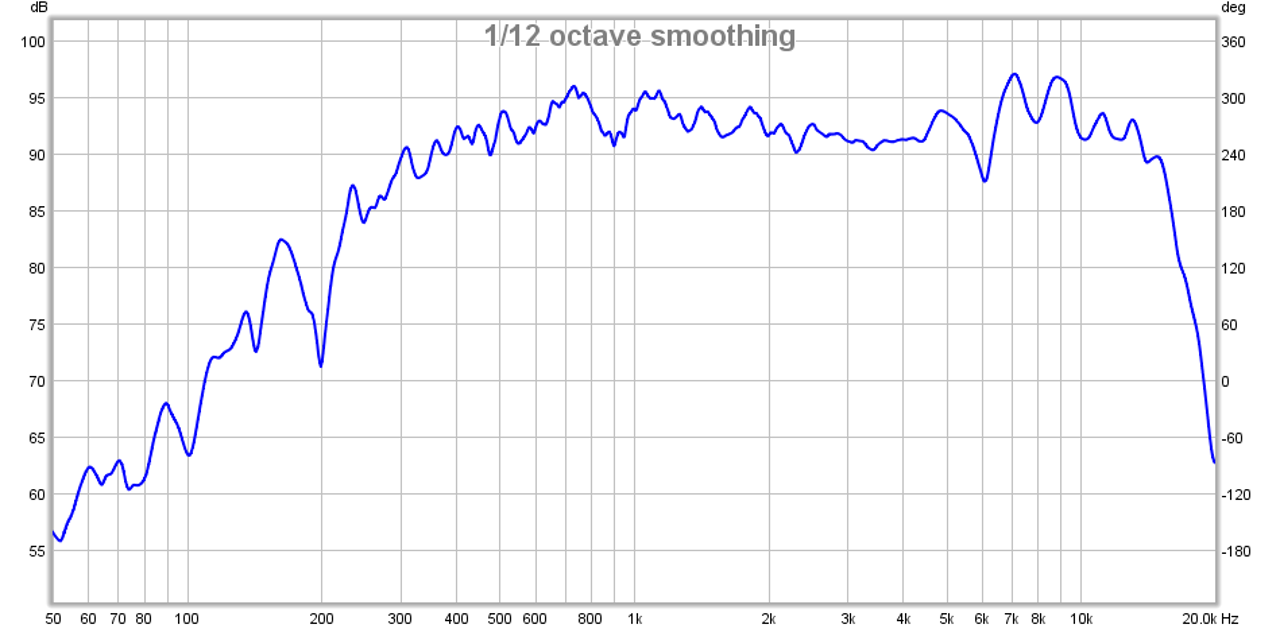
15 deg:
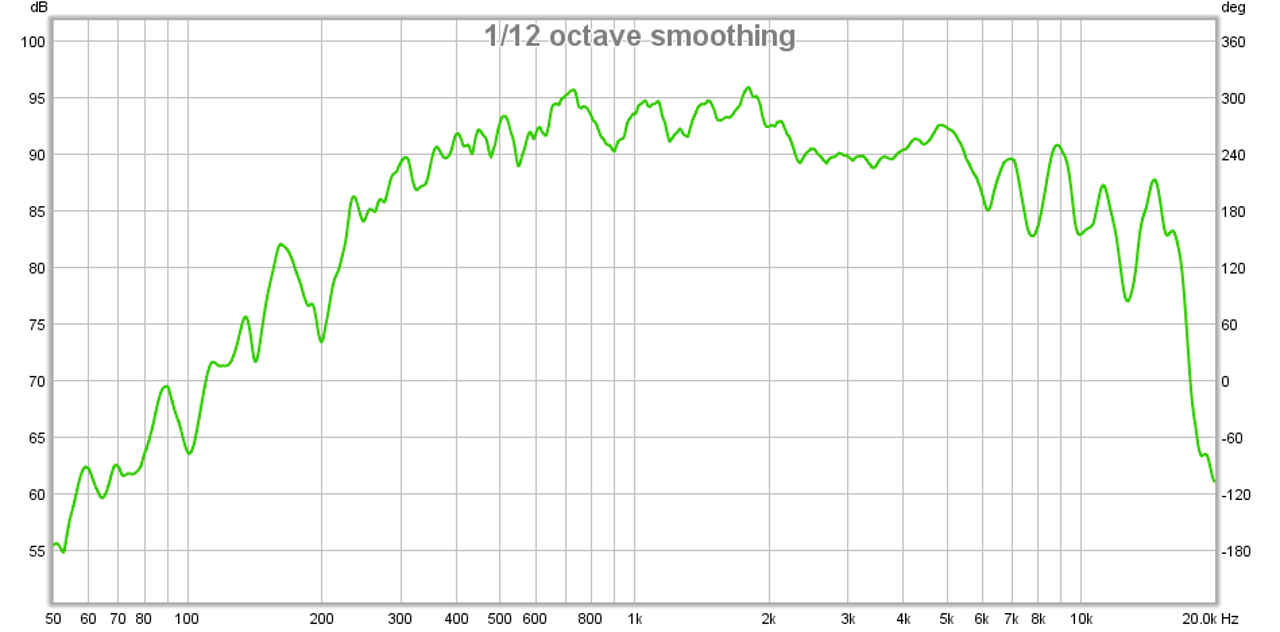
30 deg:
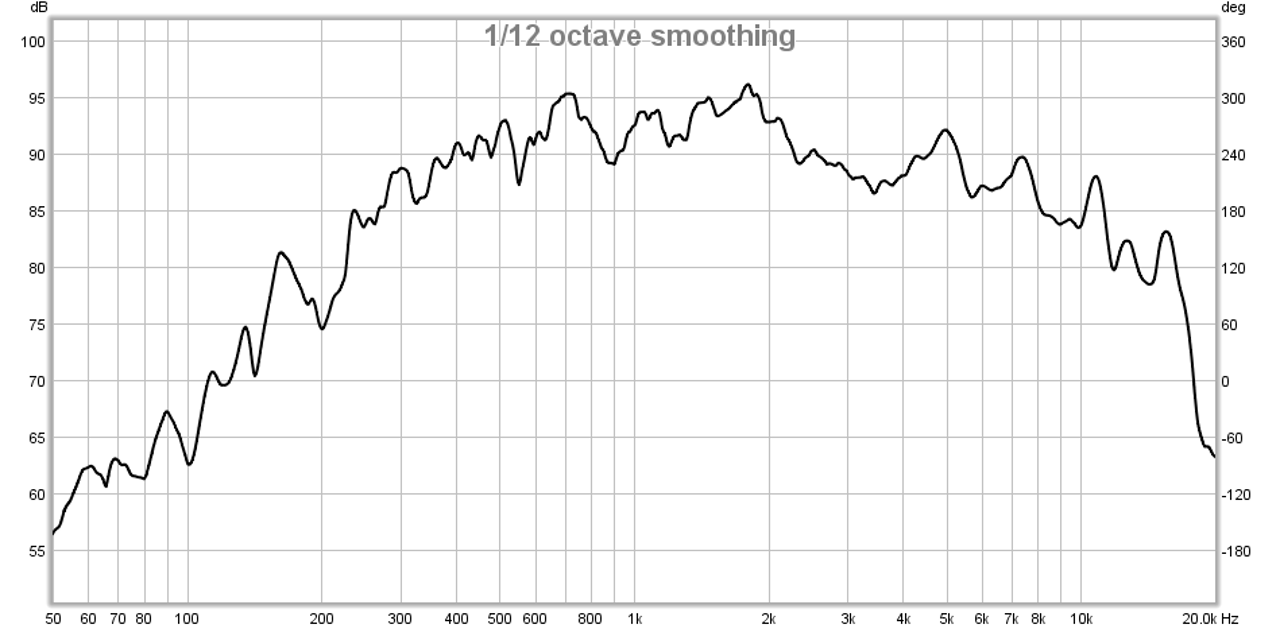
45 deg:
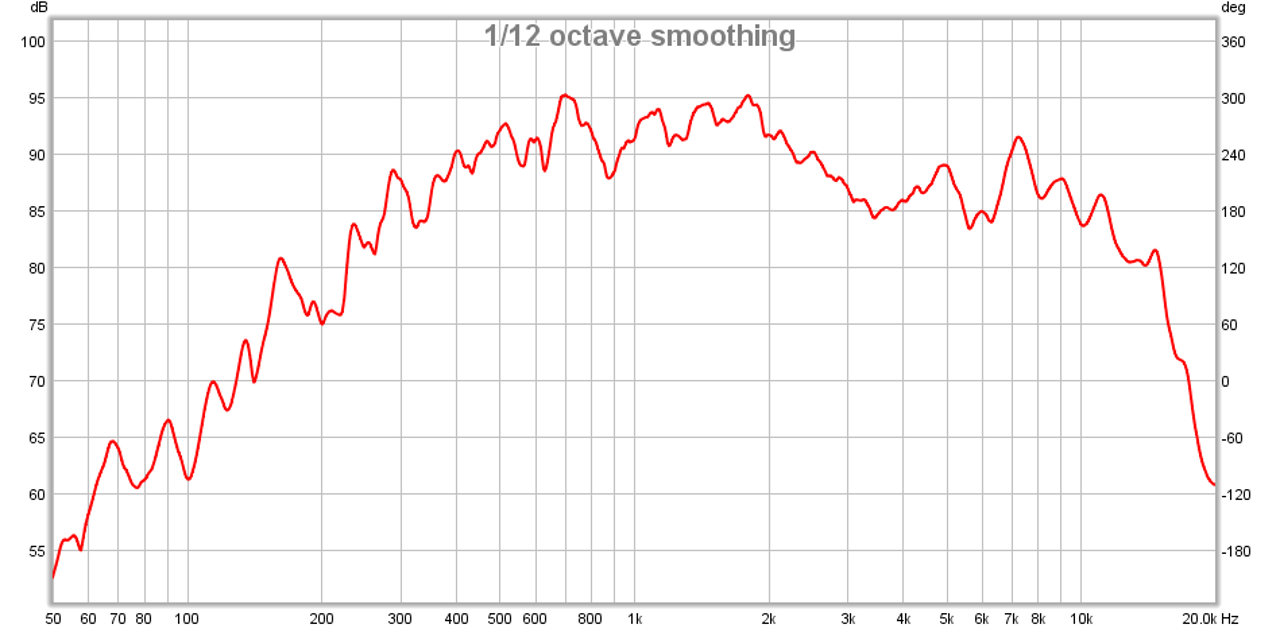
60 deg:
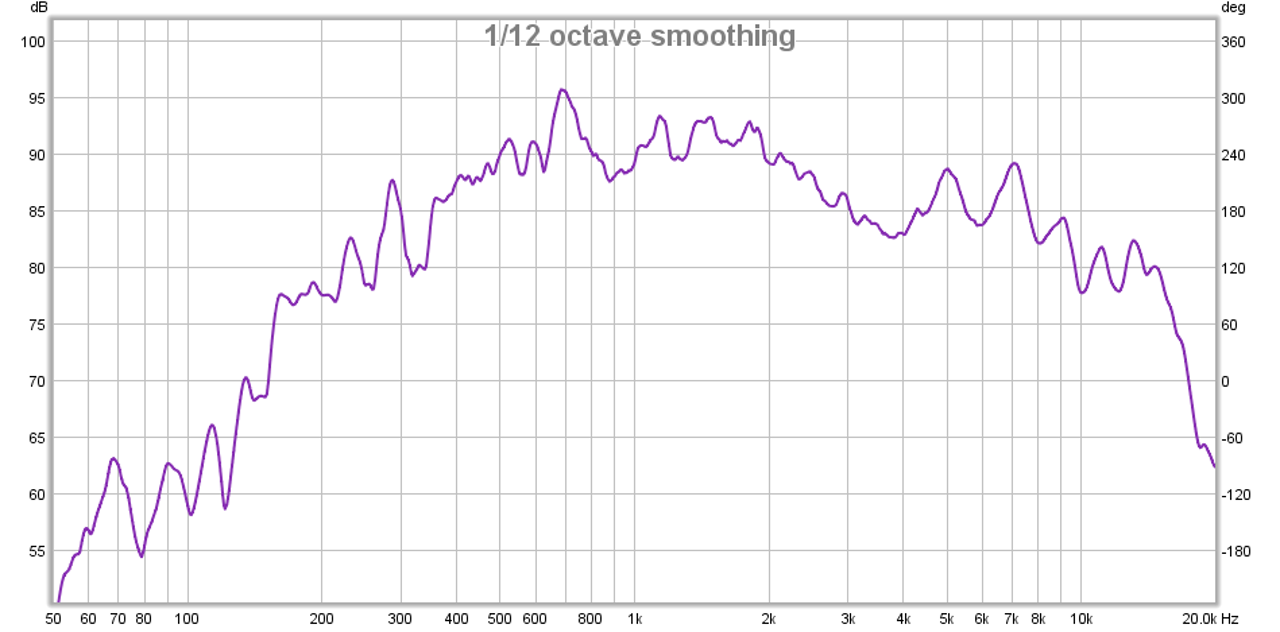
Here is the HD for the 0 deg case with a 10ms gate applied to remove near field reflections:
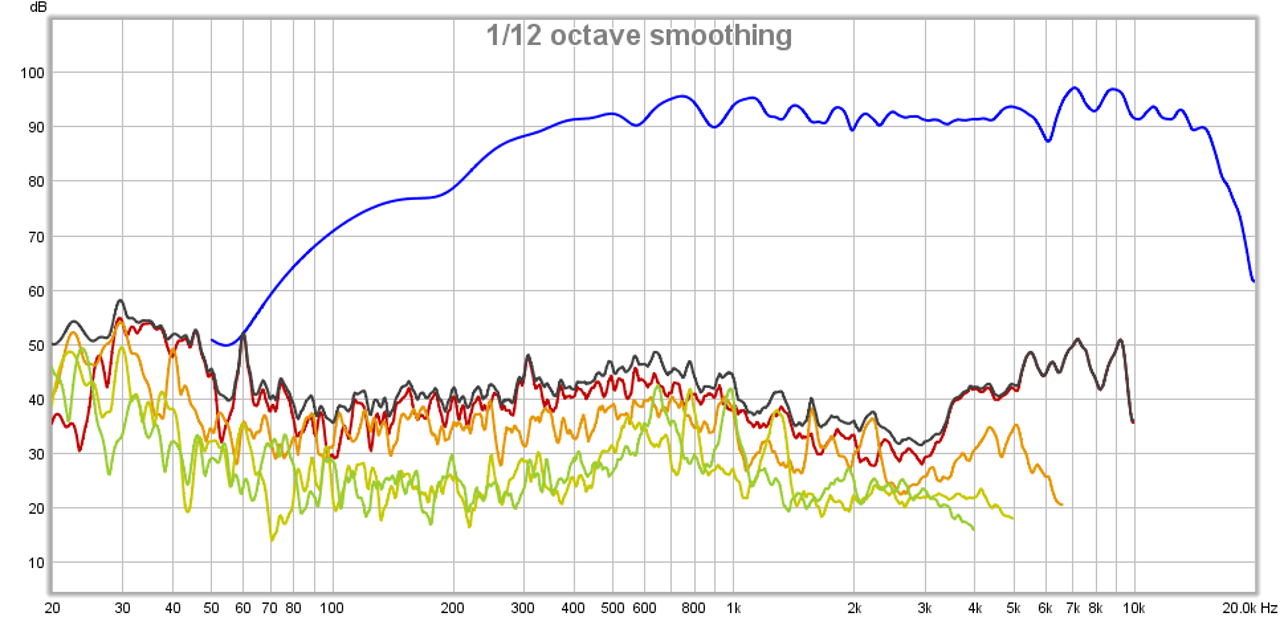
Here is the data for the 5MR450NDY mounted in my OB setup (slot loaded OB) with 5 dB major tic increments.
0 deg:
15 deg:
30 deg:
45 deg:
60 deg:
Here is the HD for the 0 deg case with a 10ms gate applied to remove near field reflections:

Attachments
Last edited:
So I ordered a set of these drivers and wanted to put them in a Nautaloss-type enclosure, but I had a couple of questions for XRK.
1) The speaker volume calculators and Parts-express are giving sealed box sizes of 2-3 liters or so. I think you recommended 6 liters or so... You put it in your Nautaloss box (I don't know how many liters. Less than 5?) and complained that it had a "congested" sound and was too small. I am wondering how that is?
2) I know that the taper of the spiral doesn't matter that much, but is there some rule-of-thumb for how long it should be, like some fraction of the lowest frequency you expect to play?
3) Do you have any guidelines for how to stuff this box? I have some Ultra Touch acoustic cotton which I can use, although I think I will need to fluff it up to have it be more like polyfill.
Let's say hypothetically, the spiral is two feet long, and the speaker is playing 200 Hz. Is that frequency even going to make it thru 2 feet of stuffing? And if it doesn't, does that make the box effectively smaller?
1) The speaker volume calculators and Parts-express are giving sealed box sizes of 2-3 liters or so. I think you recommended 6 liters or so... You put it in your Nautaloss box (I don't know how many liters. Less than 5?) and complained that it had a "congested" sound and was too small. I am wondering how that is?
2) I know that the taper of the spiral doesn't matter that much, but is there some rule-of-thumb for how long it should be, like some fraction of the lowest frequency you expect to play?
3) Do you have any guidelines for how to stuff this box? I have some Ultra Touch acoustic cotton which I can use, although I think I will need to fluff it up to have it be more like polyfill.
Let's say hypothetically, the spiral is two feet long, and the speaker is playing 200 Hz. Is that frequency even going to make it thru 2 feet of stuffing? And if it doesn't, does that make the box effectively smaller?
Beanbag,
Great to see someone else willing to give these drivers a try.
1. Congested sound comes from too small a chamber that allows reflections from the back side of the cone coming back through the cone again. The Nautaloss acts as an acoustic 'black hole' so this effect should be reduced. You still need some space around the sides of the driver to give room for the sound to get out of the rear cone and get a chance to be absorbed farther down the spiral. So even though I put the 5MR450NDY into a Nautaloss, that was designed for a 3.5 in driver, there was not quite as much room around the sides of the driver as I would have liked. If I were to make a Nautaloss for the 5MR450NDY I would make the baffle about 8 inches wide (internally) to give breathing room on the sides of the driver.
2. Set the spiral length to be longer than where you don't want the first time-of-flight reflection from the end of the spiral to be, and also to have a manageable volume and the longer the better from an absorption standpoint. Even though it is a pretty good absorber, there may be some reflections so best to put them where we can tolerate it. So for example a 36 in long spiral is 0.91 meters long, the corresponding 1/2-wave reflection is at 0.5*(342m/s)/0.91m=188Hz. This is below the critical 500Hz to 5kHz range for psychoacoustic imaging and about where the high pass filter will be so should not be a problem.
3. Stuffing should be dense at the tail and progress to loosely stuffed towards the driver with final 6 inches left unstuffed. By dense I mean compressed polyfill by volume factor of about 4 or 5, loosely stuffed is no compression at all out of the bag. Make sure you line the walls adjacent to driver with open cell foam or felt to prevent early reflections from coming back. Look a the build photos in Nautaloss thread for guidelines and examples.
Good luck!
Great to see someone else willing to give these drivers a try.
1. Congested sound comes from too small a chamber that allows reflections from the back side of the cone coming back through the cone again. The Nautaloss acts as an acoustic 'black hole' so this effect should be reduced. You still need some space around the sides of the driver to give room for the sound to get out of the rear cone and get a chance to be absorbed farther down the spiral. So even though I put the 5MR450NDY into a Nautaloss, that was designed for a 3.5 in driver, there was not quite as much room around the sides of the driver as I would have liked. If I were to make a Nautaloss for the 5MR450NDY I would make the baffle about 8 inches wide (internally) to give breathing room on the sides of the driver.
2. Set the spiral length to be longer than where you don't want the first time-of-flight reflection from the end of the spiral to be, and also to have a manageable volume and the longer the better from an absorption standpoint. Even though it is a pretty good absorber, there may be some reflections so best to put them where we can tolerate it. So for example a 36 in long spiral is 0.91 meters long, the corresponding 1/2-wave reflection is at 0.5*(342m/s)/0.91m=188Hz. This is below the critical 500Hz to 5kHz range for psychoacoustic imaging and about where the high pass filter will be so should not be a problem.
3. Stuffing should be dense at the tail and progress to loosely stuffed towards the driver with final 6 inches left unstuffed. By dense I mean compressed polyfill by volume factor of about 4 or 5, loosely stuffed is no compression at all out of the bag. Make sure you line the walls adjacent to driver with open cell foam or felt to prevent early reflections from coming back. Look a the build photos in Nautaloss thread for guidelines and examples.
Good luck!
Thanks for the fast reply.
I had plotted out a few different types of spirals in my CAD program, and there isn't a way to get a 8" opening at the speaker AND 36" long spiral AND 6 liters. I think it would have to be a hand-tweaked curve that has a big opening, and then quickly tapers down to a smaller size, and then slowly tapers towards the center. Sort of like the B&W nautalus midrange and tweeter segments. Starts out fat, stays fat for a while, then quickly tapers down to skinny, then stays skinny for a long distance.
But I think 8" wide is a bit too much for my desktop speaker requirement, so maybe some reflectors near the driver?
Did you do EQ or something else to finally get the PRV driver to sound good in the nautaloss enclosure?
I had plotted out a few different types of spirals in my CAD program, and there isn't a way to get a 8" opening at the speaker AND 36" long spiral AND 6 liters. I think it would have to be a hand-tweaked curve that has a big opening, and then quickly tapers down to a smaller size, and then slowly tapers towards the center. Sort of like the B&W nautalus midrange and tweeter segments. Starts out fat, stays fat for a while, then quickly tapers down to skinny, then stays skinny for a long distance.
But I think 8" wide is a bit too much for my desktop speaker requirement, so maybe some reflectors near the driver?
Did you do EQ or something else to finally get the PRV driver to sound good in the nautaloss enclosure?
Last edited:
Thanks for the fast reply.
I had plotted out a few different types of spirals in my CAD program, and there isn't a way to get a 8" opening at the speaker AND 36" long spiral AND 6 liters. I think it would have to be a hand-tweaked curve that has a big opening, and then quickly tapers down to a smaller size, and then slowly tapers towards the center. Sort of like the B&W nautalus midrange and tweeter segments. Starts out fat, stays fat for a while, then quickly tapers down to skinny, then stays skinny for a long distance.
But I think 8" wide is a bit too much for my desktop speaker requirement, so maybe some reflectors near the driver?
Did you do EQ or something else to finally get the PRV driver to sound good in the nautaloss enclosure?
IIRC, I applied a -5dB high shelf cut with 0.5 Q at about 900Hz for baffle step compensation and I aggressively cut the breakup peaks near 6kHz, 9kHz, 12kHz. Try not to do anything from 500Hz to 5kHz if you can avoid it, and if you do, use wide (low Q). You can go with a 7 in wide cabinet and probably would work. You are right that it is a custom spiral - I hand drew it just as you described: fat and tapering quickly after initial distance of say 8 inches to 12 inches.
A 5MR450NDY for a desktop should be awesome loud and clean!
Measurement of this driver in the slot loaded OB (SLOB) http://www.diyaudio.com/forums/full-range/249984-cheap-fast-ob-literally-39.html#post3995444 using the Breeze Audio 2.1 class D TPA3116D2 amp with built in XO for sub and tops run fullrange (NEW TPA3116 50W+50W+100W 2.1 HIFI digital power amplifier HIFI beyond TPA3123 TDA2030 LM1875-in Amplifier from Electronics on Aliexpress.com | Alibaba Group). The perfect integration of the falloff at 340 Hz and the woofer channel was pure luck as the XO frequency on the amp is not adjustable - just relative gains. Anyhow, it measures pretty well given that this is raw with no DSP, no EQ. Straight from source to amp.
Can you comment any further on this amplifier - compared to more known brands
The Breeze Audio 2.1 TPA3116D2 amp has dual TPA3116 chips with one serving as the stereo duties in full range and a second chip configured as parallel bridge tied load (PBTL) for 100 watts mono, stable into 2 ohm loads for the sub. It has an op amp stage that provides a low pass with adjustable gain and slope of the low pass filter. The specs say that the XO freq is adjustable, but my measurements show it is kind of fixed with the slope changing (which indirectly affects the XO freq). The amp is fairly well made with middle of the road components many of which are thru-hole type suitable for the DIYer to modify easily. There have been some quality control issues with these amps but Aliexpress is very good about refunding bad units that are delivered, often without having to send defective unit back to China. Having said that, if you happen to get a good unit - it can sound quite good. Certainly in stock form it will not be as good as a modded YJ Danzz black/blue TPA3116D2 with OSCON's, bootstrap cap upgrades, snubber upgrades, etc. But quite good given the price and fact it is cased in aluminum with volume and level knobs and binding posts. The best thing about it is that it's sub woofer XO perfectly matches the OB design I have. I have used it with a slot loaded push pull sub and it works very well there too. Full disclosure: I did not buy this amp but a unit that was DOA from Aliexpress was given to me by another member. It had a couple of bad bootstrap caps that had broken off in transit as they were radial leads and were bent back and forth by the movement of the rather heavy inductors adjacent to them. It was an easy fix. There is also the common problem of dislodged heatsinks during transport. Many other brands have this issue as the aluminum heatsinks are held on with double sided tape and come off. Again, easy fix.
There are probably other 2.1 amps out there I just happened to get lucky with the XO on this one. Hope that helps.
There are probably other 2.1 amps out there I just happened to get lucky with the XO on this one. Hope that helps.
Perhaps 6 channels in and 6 channels out TPA3116 may work?
Great for active 3-way stereo pair.
http://www.yuan-jing.com/tpa3116-class-d-6-0-channels-stereo-amplifier-50w-x-6
Great for active 3-way stereo pair.
http://www.yuan-jing.com/tpa3116-class-d-6-0-channels-stereo-amplifier-50w-x-6
Perhaps 6 channels in and 6 channels out TPA3116 may work?
Great for active 3-way stereo pair.
http://www.yuan-jing.com/tpa3116-class-d-6-0-channels-stereo-amplifier-50w-x-6
I already have a Tripath 2022 eval board with 6 in 6 out, but not wired up yet. Have you any experience with the 2022 chip compared to tpa3116?
- Home
- Loudspeakers
- Full Range
- PRV 5MR450-NDY for FAST/WAW applications
